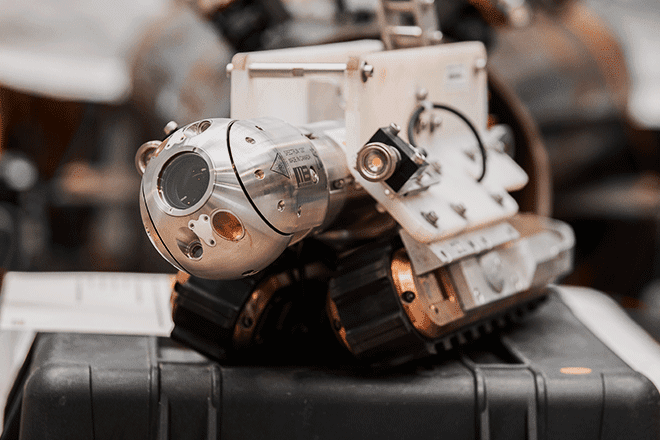SD vs. HD vs. 4K

Industrial inspection imagery might, on the surface, seem to be lagging behind that of consumer electronics. When it comes to TV and movie viewing, the move from SD (Standard Definition) to HD (High Definition) has been swift, and today we’re making the jump to 4K (or Ultra High Definition).
Yet, inspection cameras utilising SD images and video are still the most commonplace offering.
The reasons for this are multiple – but the world is changing. Clarity is everything when it comes to inspection images. However, the field is somewhat more complex than of the movie and TV worlds – and it’s mainly due to the equipment itself.
Inspection Cameras: The limitations
To discuss why inspection cameras can’t simply plug into this latest technology, we first need to understand the difference between SD, HD and 4K.
Colour images are made up of pixels (tiny dots) that create the image we see. The more dots, the better the image.
- SD comprises 240p (pixels) to 480p.
- A full-strength HD video is 1080p
- Anything above that is is 4K (sometimes referred to as Ultra-HD or UHD)
When an inspection camera captures images and video the information is conveyed through text and signals. This data is specific to the system, so an HD camera can’t interpret through to an SD configuration. This means you can’t simply add an HD camera to, say, an SD-configured crawler, as the images won’t translate. The complete set-up needs to be compatible.
The Inuktun Advantage
Of course, the solution is for manufacturers to construct unique instruments with full 1080p HD video capability – something that industry leader, Inuktun, has been tirelessly working to develop. Two RVI (Remote Video Inspection) systems that already embrace full HD technology are:
- The Spectrum 120HDTMPTZ Camera
- MaggHDTM Miniature Magnetic Crawler
Both offer real time recording of live HD video, HD still images and sensor data. They’re controlled via a PC-based system that allows for direct recording of HD video to the hard drive.
Inuktun also offers a similar solution for underwater and ariel inspection:
- The Spectrum 120HDTM: Measuring only 120mm in diameter, this RVI inspection tool can be integrated into a remote crawler system or used as a standalone tool. With an optical zoom facility up to 30X, it’s already proving its worth with successful deployment into challenging areas, such as pipelines, storage vessels, mine shafts and pressure vessels.
4K Inspection: When only the greatest accuracy will suffice
4K imagery offers the ultimate inspection quality. When it comes to vertical inspection solutions this is well-served by the cutting-edge Zenith 4K Inspection Camera.
The 4K (or UHD) video imagery provides accuracy of a quality never-before seen. The definition is so great it allows inspectors to pinpoint even the smallest of defects, bringing them into full frame, in real-time and from a distance of up to 10 metres – without losing any clarity. A simple to use, remotely operated drop camera system, the next-generation Zenith 4K inspection camera allows for fully automated inspections of every kind of vertical asset – no matter how hard they might be to reach.
HD/4K Storage Challenges – Solved.
Of course, the improved visual quality comes at a price – and that’s one of storage. Detailed data does, of course, take up more space. Running out of room during a critical inspection certainly isn’t a desired scenario.
Storage is measured in Bit rate. This is the number of bits required for the recording of one second of video – written as bps (bits-per-second) – and, therefore, the size of storage needed.
For example, the bit rate for a second of low quality SD images is 1Mps, whereas that of high quality HD is 20Mps. When this is applied to an hour of storage, the difference is significant – that of 450MB to 9G.
Inuktun has addressed this with the provision of a number of applications for real-time, simultaneous recording of multiple streams of SD and HD video. The ICON And InPRO utilise IM3 technology that allow for the recording of up to one HD and two SD streams at the same time, or two HD streams. The capability is thanks to the use of any current Intel CPU that’s Quik-Sync GPU enabled, as well as video files being stored with H.264 compression algorithms. Various bitrate compressions can be tailored for bespoke quality options.
HD and 4K Inspection Equipment is a Constantly Evolving
Job-appropriate RVI inspection solutions are best approached by determining not only current needs, but also those of the future. The provision of the latest technology without the flexibility to embrace advancing utilities can be costly and, ultimately, harm an operations baseline profits.
The Nexxis approach commits to a global appraisal of equipment that’s truly future-proof, meaning customers not only take advantage of today’s tech, but gain a dynamic solution with the ability to evolve as new technical equipment becomes available. That way a business achieves a tailor-made solution for its individual needs.
Visit our website to find out more and get in touch to discover our full range of advanced HD RVI cameras and crawlers or contact us today for a no-obligation chat.
